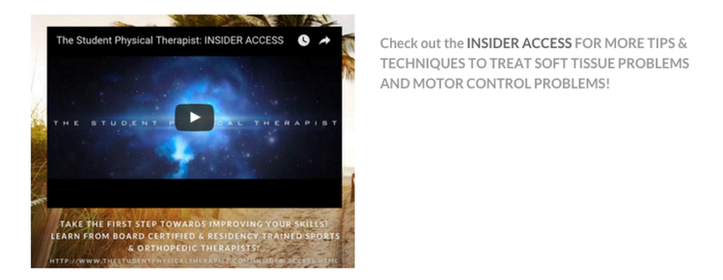- Home
- About Us
- TSPT Academy
- Online Courses
-
Resources
- Newsletter
- Business Minded Sports Physio Podcast
- Day in the Life of a Sports PT
- Residency Corner
-
Special Tests
>
-
Cervical Spine
>
- Alar Ligament Test
- Bakody's Sign
- Cervical Distraction Test
- Cervical Rotation Lateral Flexion Test
- Craniocervical Flexion Test (CCFT)
- Deep Neck Flexor Endurance Test
- Posterior-Anterior Segmental Mobility
- Segmental Mobility
- Sharp-Purser Test
- Spurling's Maneuver
- Transverse Ligament Test
- ULNT - Median
- ULNT - Radial
- ULNT - Ulnar
- Vertebral Artery Test
- Thoracic Spine >
-
Lumbar Spine/Sacroiliac Joint
>
- Active Sit-Up Test
- Alternate Gillet Test
- Crossed Straight Leg Raise Test
- Extensor Endurance Test
- FABER Test
- Fortin's Sign
- Gaenslen Test
- Gillet Test
- Gower's Sign
- Lumbar Quadrant Test
- POSH Test
- Posteroanterior Mobility
- Prone Knee Bend Test
- Prone Instability Test
- Resisted Abduction Test
- Sacral Clearing Test
- Seated Forward Flexion Test
- SIJ Compression/Distraction Test
- Slump Test
- Sphinx Test
- Spine Rotators & Multifidus Test
- Squish Test
- Standing Forward Flexion Test
- Straight Leg Raise Test
- Supine to Long Sit Test
-
Shoulder
>
- Active Compression Test
- Anterior Apprehension
- Biceps Load Test II
- Drop Arm Sign
- External Rotation Lag Sign
- Hawkins-Kennedy Impingement Sign
- Horizontal Adduction Test
- Internal Rotation Lag Sign
- Jobe Test
- Ludington's Test
- Neer Test
- Painful Arc Sign
- Pronated Load Test
- Resisted Supination External Rotation Test
- Speed's Test
- Posterior Apprehension
- Sulcus Sign
- Thoracic Outlet Tests >
- Yergason's Test
- Elbow >
- Wrist/Hand >
- Hip >
- Knee >
- Foot/Ankle >
-
Cervical Spine
>
- I want Financial Freedom
- I want Professional Growth
- I want Clinical Mastery
 Last week, I was treating another PT's patient with the diagnosis of patellafemoral pain syndrome (PFPS). On this day she was complaining of L lateral foot pain after having to wear heels a couple times during the week. With the location of pain, we should immediately develop multiple hypotheses. The patient's asterisk sign was lateral foot pain/tightness with lumbar flexion while in a half lateral split position. Initial hypotheses based on pain position could suggest cuboid dysfunction, S1 radiculopathy, Intermediate Dorsal Cutaneous neural tension, peroneal strain, lateral ankle sprain, or more. I immediately found no local pain with palpation or muscle testing (making these diagnoses less likely), so my mind went to the spine. I did have some mild pain recreation with common peroneal neural tensioning, but it wasn't a significant amount. While the patient did have some lumbar mobility restrictions, mobilizing the lumbar spine and performing repeated motions had limited improvement in the asterisk sign. Even though I typically like to start at the spine with treatment, some cases are more peripherally based. At this point I addressed the proximal tib-fib joint restriction due to the proximity of the common peroneal nerve, which has a distal branch known as the Intermediate Dorsal Cutaneous nerve. Still no significant change in the asterisk sign occurred. Fortunately, earlier this year I took a course on dry needling. One of the things I found most beneficial in the course was learning about trigger point referral patterns. A commonly involved muscle, and the culprit in this case, is the gluteus minimus. While the muscle frequently presents with local pain and a "sciatica-like" distribution, it can also present with lateral foot pain (based on the trigger point charts in our dry needling workbooks). After needling this muscle, the patient's asterisk sign significantly improved and the patient returned this week with no more pain in that foot. The lesson from a case like this is that we should not become overly focused on one body region. While many injuries will respond to treatment through different methods, there are certain injuries that require specific treatment. -Dr. Chris Fox, PT, DPT, OCS
0 Comments
Leave a Reply. |
Dr. Brian Schwabe's NEW Book in partner with PaleoHacks!
Learn residency-level content on our
Insider Access pages We value quality PT education & CEU's. Click the MedBridge logo below for TSPT savings!Archives
July 2019
Categories
All
|








 RSS Feed
RSS Feed